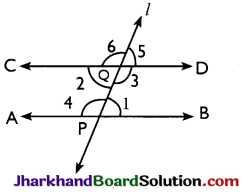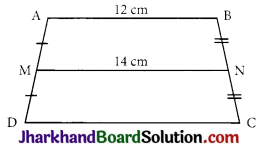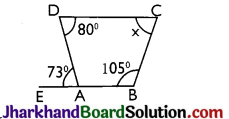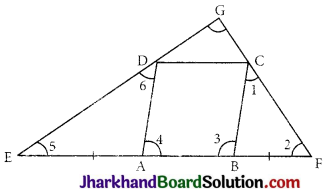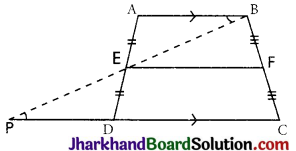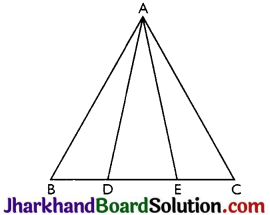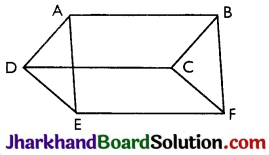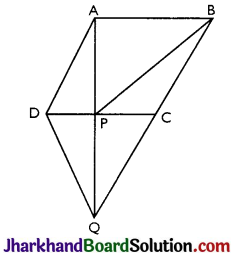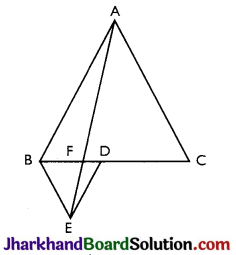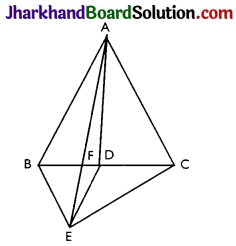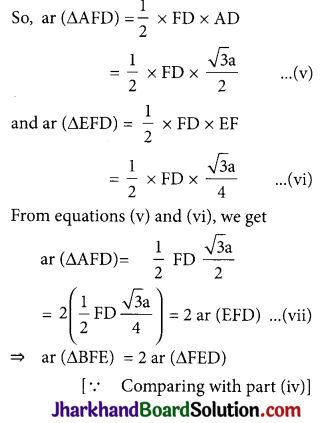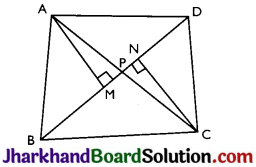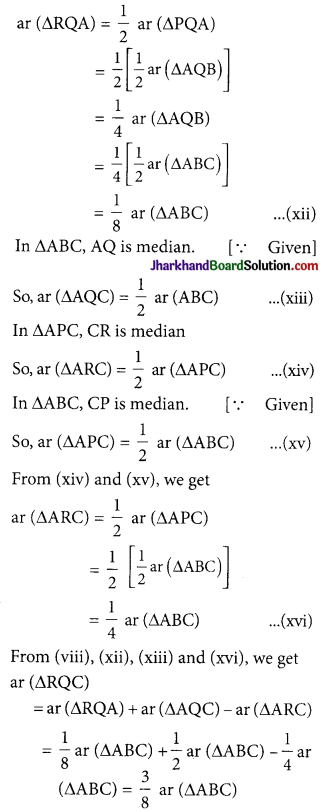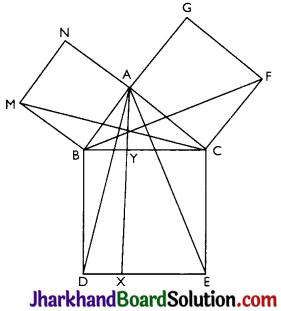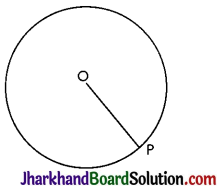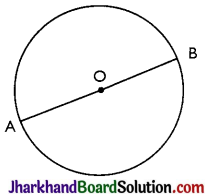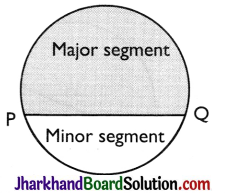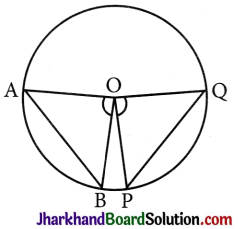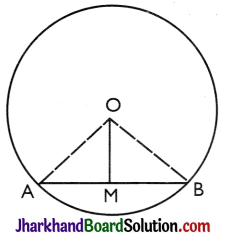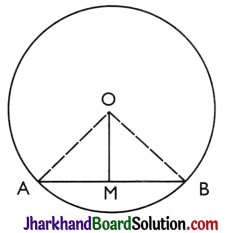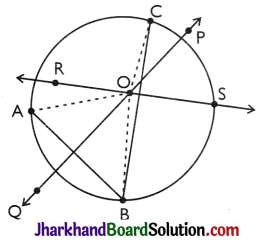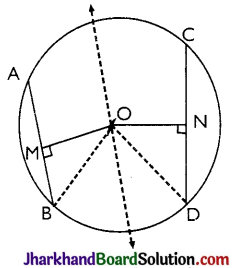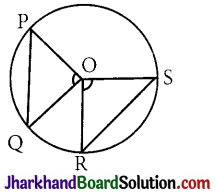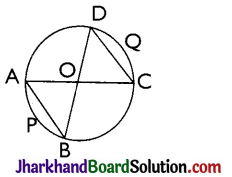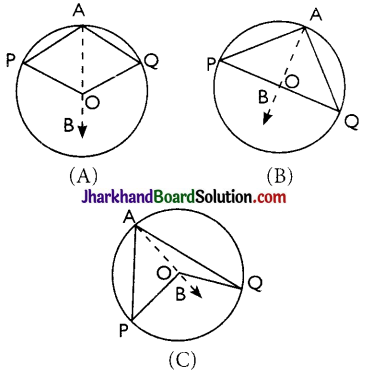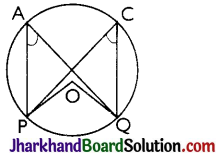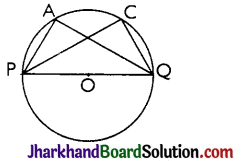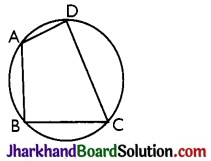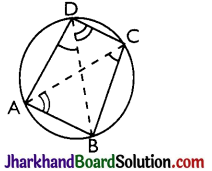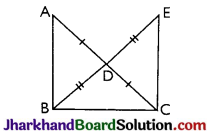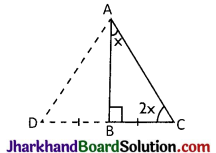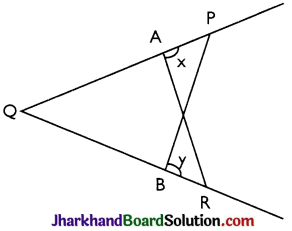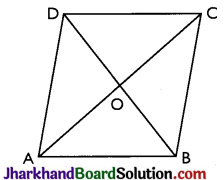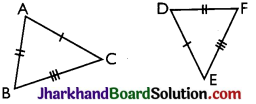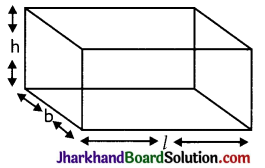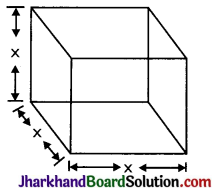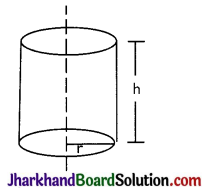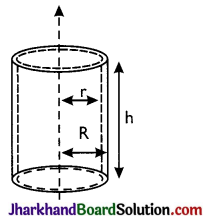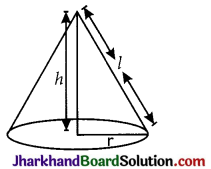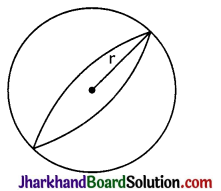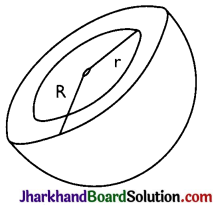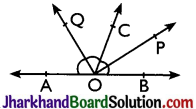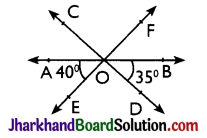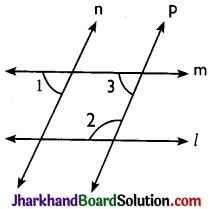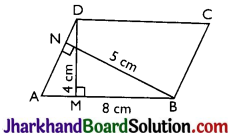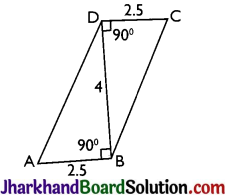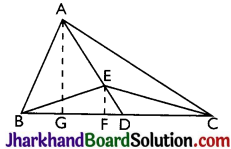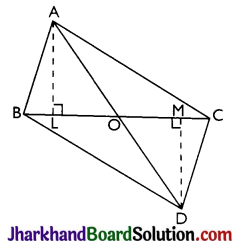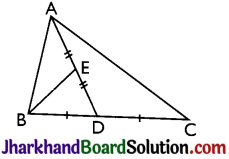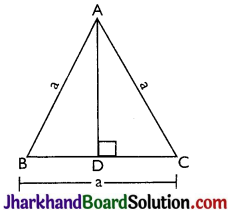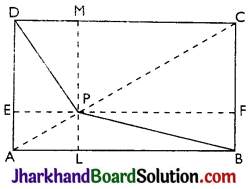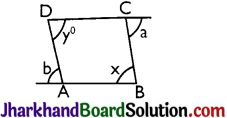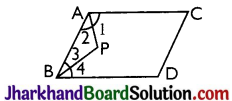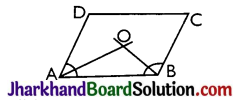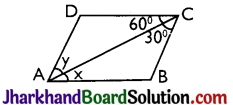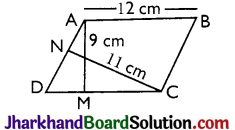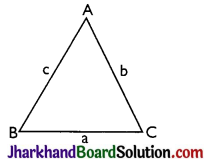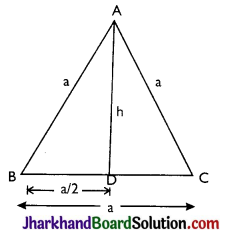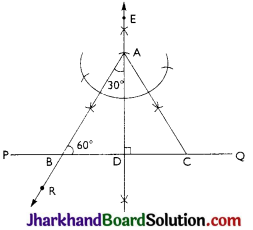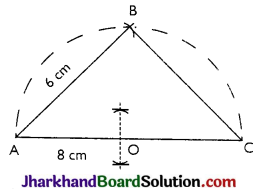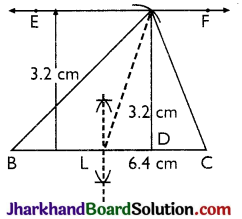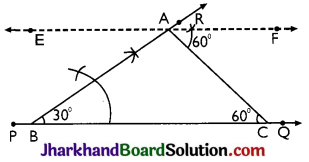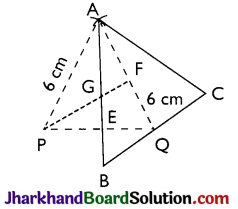Jharkhand Board JAC Class 9 Sanskrit Solutions Shemushi Chapter 1 भारतीवसन्तगीतिः Textbook Exercise Questions and Answers.
JAC Board Class 9th Sanskrit Solutions Shemushi Chapter 1 भारतीवसन्तगीतिः
JAC Class 9th Sanskrit भारतीवसन्तगीतिः Textbook Questions and Answers
1. एकपदेन उत्तरं लिखत-(एक शब्द में उत्तर दीजिये-)
(क) कविः कां सम्बोधयति? (कवि किसको संबोधित करता है?)
उत्तरम् :
वाणीम् (वाणी को)।
(ख) कविः वाणीं कां वादयितुं प्रार्थयति? (कवि वाणी से क्या बजाने की प्रार्थना करता है?)
उत्तरम् :
वीणाम्। (वीणा को)
(ग) कीदृशीं वीणां निनादयितुं प्रार्थयति? (कैसी वीणा बजाने की प्रार्थना करता है?)
उत्तरम् :
नवीनाम् (नई वीणा को)।

(घ) गीति कथं गातुं कथयति? (कैसा गीत गाने के लिए कहता है?)
उत्तरम् :
नीतिलीनाम् (नीति से पूर्ण)।
(ङ) सरसाः रसालाः कदा लसन्ति? (रसीले आम कब शोभा देते हैं ?)
उत्तरम् :
वसन्ते (वसन्तु ऋतु में)।
2. पूर्णवाक्येन उत्तरं लिखत-(पूरे वाक्य में उत्तर दीजिये-)
(क) कविः वाणी किं कथयति? (कवि वाणी को क्या कहता है?)
उत्तरम् :
कविः वाणी नवीनां वीणां निनादयितुं कथयति। (कवि वाणी को नई वीणा बजाने के लिए कहता है।)
(ख) वसन्ते किं भवति? (वसन्त ऋतु में क्या होता है?)
उत्तरम् :
वसन्ते मधुर-मञ्जरी-भूतमालाः सरसा:-रसालाः लसन्ति। (वसन्त में मधुर मंजरियों से पीले वर्ण से युक्त रसीले आमों के वृक्ष शोभा देते हैं।)
(ग) सलिलं तव वीणामाकर्ण्य कथम् उच्चलेत्? (पानी तुम्हारी वीणा को सुनकर कैसे उछलता है?)
उत्तरम् :
तव वीणामाकर्ण्य सलीलं जलमुच्चलेत्। (तुम्हारी वीणा को सुनकर पानी खेल ही खेल में उछलता है।)
(घ) कविः भगवतीं भारती कस्याः तीरे मधुमाधवीनां नतां पंक्तिम् अवलोक्य वीणां वादयितुं कथयति? (कवि भगवती भारती (सरस्वती) से किस नदी के तट पर (कहाँ) मधुमाधवी की झुकी हुई पंक्तियों को देखकर वीणा को बजाने के लिए कहता है?)
उत्तरम् :
कविः भगवर्ती भारती कलिन्दात्मजायाः सवानीरतीरे मधुमाधवीनां नतां पंक्तिम् अवलोक्य वीणां वादयितुं कथयति। (कवि भगवती भारती (सरस्वती) से यमुना नदी के बेंत की लताओं से युक्त तट पर मधुर मालती की झुकी हुई पंक्तियों को देखकर वीणा बजाने के लिए कहता है।)

3. ‘क’ स्तम्भे पदानि ‘ख’ स्तम्भे तेषां पर्यायपदानि दत्तानि। तानि चित्वा पदानां समक्षे लिखत –
(‘क’ स्तम्भ के पदों के पर्यायपद ‘ख’ स्तम्भ में दिये गये हैं, उनमें से सही पद चुनकर उनके समक्ष लिखिए-)
| ‘क’ स्तम्भः | ‘ख’ स्तम्भः |
| (क) सरस्वती | 1. तीरे |
| (ख) आम्रम् | 2. अलीनाम् |
| (ग) पवनः | 3. समीरः |
| (घ) तटे | 4. वाणी |
| (ङ) भ्रमराणाम् | 5. रसालः |
उत्तरम् :
| ‘क’ स्तम्भः | ‘ख’ स्तम्भः |
| (क) सरस्वती | 4. वाणी |
| (ख) आम्रम् | 5. रसालः |
| (ग) पवनः | 3. समीरः |
| (घ) तटे | 1. तीरे |
| (ङ) भ्रमराणाम् | 2. अलीनाम् |
4. अधोलिखितानि पदानि प्रयुज्य संस्कृतभाषया वाक्यरचनां कुरुत –
(निम्नलिखित पदों का प्रयोग करते हुए संस्कृत-भाषा में वाक्य-रचना कीजिए)
(क) निनादय
(ख) मन्दमन्दम्
(ग) मारुतः
(घ) सलिलम्
(ङ) सुमनः
उत्तरम् :
वाक्यरचना –
(क) निनादय – अये वाणि! नवीनां वीणां निनादय। (हे सरस्वती! नवीन वीणा को बजाओ।)
(ख) मन्दमन्दम् – कलिन्दात्मजायाः सवानीरतीरे समीरः मन्दमन्दं वहति। (यमुना नदी के बेंत की लताओं से युक्त तट पर हवा धीरे-धीरे चलती है।)
(ग) मारुतः – सायंकाले मारुतः मन्द-मन्दं वहति। (सायंकाल हवा धीरे-धीरे चलती है।)
(घ) सलिलम् – अये वाणि! तव नवीनां वीणाम् आकर्ण्य नदीनां कान्तसलिलं सलीलम् उच्छलेत्। (हे सरस्वती ! तुम्हारी नवीन वीणा को सुनकर नदियों का सुन्दर जल खेल-खेल में उछल पड़े।)
(ङ) सुमनः – पुष्पस्य पर्यायं सुमनः अस्ति। (पुष्प का पर्यायवाची सुमन है।)
5. प्रथमश्लोकस्य आशयं हिन्दीभाषया आङ्गलभाषया वा लिखत।
(प्रथम श्लोक का आशय हिन्दी अथवा अंग्रेजी भाषा में लिखिए।)
उत्तरम् :
प्रथम श्लोक का आशय-हे माँ वाणी (सरस्वती)! आप अपनी वीणा से ऐसे सुन्दर नीतियों से युक्त गीत का मधुर गान करो, जिसे सुनकर समस्त चराचर में सौन्दर्य के प्रति चेतना जाग्रत हो जाए। प्राणी नीति के मार्ग पर अग्रसर हों।
हे माता सरस्वती! वसन्त ऋतु आ गई है। आम के वृक्ष बौरा गए हैं। अमराइयाँ पीली कान्ति से युक्त हो गई हैं। उन आम्र-वृक्षों पर कूकती कोयलों के समूह मनमोहक लगते हैं। फिर भी परतन्त्र भारतीयों के मनों में उत्साह नहीं है। हे माँ सरस्वती ! आप ऐसी वीणा बजाइये, जिससे सभी भारतीयों के मनों में उत्साह भर जाये और वे भारत-माता की स्वतन्त्रता का मार्ग प्रशस्त करें।

6. अधोलिखितपदानां विलोमपदानि लिखत – (निम्नलिखित पदों के विलोमपद लिखिए।)
(क) कठोरम् ………..
(ख) कटु …………
(ग) शीघ्रम् ………..
(घ) प्राचीनम् ……….
(ङ) नीरस: ……….
उत्तरम् :
पदानि – विलोमपदानि
(क) कठोरम् – कोमलम्
(ख) कटु – मृदु
(ग) शीघ्रम् – विलम्बम्
(घ) प्राचीनम् – नवीनम्
(ङ) नीरसः – सरस:
JAC Class 9th Sanskrit भारतीवसन्तगीतिः Important Questions and Answers
प्रश्न: 1.
वाणी किं निनादय? (सरस्वती क्या बजाये?)
उत्तरम् :
वाणी नवीनां वीणां निनादय। (सरस्वती नवीनता से युक्त वीणा को बजाये।)
प्रश्न: 2.
वसन्ते के लसन्ति? (वसन्त में क्या सुशोभित होते हैं ?)
उत्तरम् :
वसन्ते मधुरमञ्जरी-पिञ्जरी-भूतमालाः सरसा: रसाला: लसन्ति। (वसन्त में मधुर मञ्जरियों से पीली हुई सरस आम के वृक्षों की पंक्तियाँ सुशोभित होती हैं।)
प्रश्न: 3.
मन्दमन्दं कः वहति? (धीरे-धीरे क्या बहता है?)
उत्तरम् :
सनीर: समीर: मन्दमन्दं वहति। (जल से युक्त पवन धीरे-धीरे बहता है।)
प्रश्न: 4.
सवानीरतीरः कस्याः अस्ति? (बेंत की लताओं से आच्छादित तट किसका है?)
उत्तरम् :
कलिन्दात्मजायाः सवानीरतीरः अस्ति। (यमुना का तट बेंत की लताओं से आच्छादित है।)

प्रश्नः 5.
पादपाः कैः युक्ताः? (वृक्ष किनसे युक्त हैं?)
उत्तरम् :
पादपाः ललितपल्लवैः युक्ताः सन्ति। (वृक्ष मन को आकर्षित करने वाले पत्तों से युक्त हैं।)
प्रश्नः 6.
अलीनां ततिम् किं करोति? (भ्रमरों की पंक्ति क्या करती है?)
उत्तरम् :
अलीनां ततिम् स्वनन्तीम्। (भ्रमरों की पंक्ति ध्वनि करती है।)
प्रश्न: 7.
किं कृत्वा वीणां निनादयितुं कथितः? (क्या करके वीणा को बजाने के लिए कहा गया है?)
उत्तरम् :
पादपे पुष्पपुजे, मञ्जुकुञ्ज, अलीनां मलिनं ततिं दृष्ट्वा वीणां निनादयितुं कथितः। (वृक्षों पर, पुष्पों के समूह पर, सुन्दर कुञ्जों पर भौंरों की काली पंक्ति अथवा भौरों के काले समूह को देखकर वीणा बजाने को कहा गया है।)
प्रश्न: 8.
कीदृशीं वीणां निनादयितुं कथितः? (कैसी वीणा बजाने के लिए कहा गया है?)
उत्तरम् :
नवीनां वीणां निनादयितुं कथितः। (नवीन वीणा को बजाने के लिए कहा गया है।)
प्रश्न: 9.
वीणाम् आकर्ण्य सुमं किं कुर्यात्? (वीणा को सुनकर पुष्प क्या करे?)
उत्तरम् :
वीणाम् आकर्ण्य सुमं चलेत्। (वीणा को सुनकर पुष्प चलायमान हो जाये।)

प्रश्न: 10.
नदीनां जलं कथम् उच्छलेत्? (नदियों का जल कैसे उछल पड़े?)
उत्तरम् :
नदीनां जलं सलीलम् उच्छलेत्। (नदियों का जल खेल-खेल में उछल पड़े।)
प्रश्न: 11.
वाणी कीदृशीं गीतिं गायतु? (वाणी कैसा गीत गाये?)
उत्तरम् :
वाणी ललित-नीति-लीनाम् गीतिम् गायतु। (वाणी सुन्दर नीति से युक्त गीत गाये।
प्रश्न: 12.
केषां कलापाः लसन्ति? (किनके समूह शोभा दे रहे हैं?)
उत्तरम् :
ललित-कोकिला-काकलीनां कलापाः लसन्ति। (सुन्दर कोमल स्वरों के समूह शोभा देते हैं।)
प्रश्न: 13.
यमुना तीरे केषां नतां पंक्तिमालोक्य वाणी वीणां निनादयतु? (यमुना के किनारे किनकी झुकी हुई पंक्ति को देखकर वाणी वीणा वादन करे।)
उत्तरम् :
मधुमाधवीनां पंक्तिमालोक्य वाणी वीणां निनादयतु। (मधुर माधवी लताओं को देखकर वाणी वीणा बजाये।)
प्रश्न: 14.
पुष्प पुजे केषा ततिः स्वनति? (पुष्पसमूह पर किनकी पंक्ति स्वर करती है ?)
उत्तरम् :
पुष्प पुजे अलीनाम् पक्तिः स्वनति। (पुष्पसमूह पर भौरों की पंक्ति स्वर करता है।)

प्रश्न: 15.
‘भारतीवसन्तगीतिः’ कस्य रचना अस्ति? (‘भारतीवसन्तगीतिः’ किसकी रचना है? )
उत्तरम् :
भारतीवसन्तगीति : पं. जानकी वल्लभ शास्त्रिण: रचना अस्ति। (भारतीवसन्तगीति पं. जानकी वल्लभ शास्त्री की रचना है।
रेखांकित पदान्यधिकृत्य प्रश्न निर्माणं कुरुत। (रेखांकित शब्दों के आधार पर प्रश्न निर्माण कीजिए।)
प्रश्न: 1.
वसन्ते लसन्ति सरसाः रसालाः। (वसन्त में सरस आम शोभा देते हैं।)
उत्तरम् :
वसन्ते के लसन्ति? (वसन्त में कौन शोभा देते हैं?)
प्रश्न: 2.
वाणी नवीनां वीणां निनादयतु? (वाणी नई वीणा बजाये।)
उत्तरम् :
वाणी कीदृशी वीणां निनादयतु? (वाणी कैसी वीणा बजाये?)
प्रश्न: 3.
वहति मन्द-मन्द सनीरः समीरः। (धीरे-धीरे सजल वायु चलती है।)
उत्तरम् :
मन्दम् मन्दम् कीदृशः समीर: वहति? (धीरे-धीरे कैसी हवा चलती है?)

प्रश्न: 4.
उच्छलेत् कान्तं सलिलम्। (सुन्दर जल उछले।)
उत्तरम् :
कीदृशं सलिलं उच्छलेत्। (कैसा पानी उछले?)
प्रश्नः 5.
तवाकर्ण्य वीणामदीनां नदीनां जलं उच्छलेत्। (तुम्हारी ओजस्वी वीणा को सुनकर नदियों का जल उछल पड़े।)
उत्तरम् :
नदीनां जलं काम् आकर्ण्य उच्छलेत्? (नदियों का जल क्या सुनकर उछल पड़े?)
परियोजना-कार्यम्
पाठेऽस्मिन् वीणायाः चर्चा अस्ति। अन्येषां पञ्चवाद्ययन्त्राणां चित्रं रचयित्वा संकलय्य वा तेषां नामानि लिखत।
(इस पाठ में वीणा की चर्चा है। दूसरे पाँच वाद्य-यन्त्रों के चित्र बनाकर अथवा संकलित करके उनके नाम लिखिए।) निर्देश-यहाँ कुछ वाद्य-यन्त्रों के नाम संस्कृत में दिये जा रहे हैं, छात्र इनके चित्र स्वयं बनाएँ या उनका संकलन करें।
वाद्य यन्त्र – (1) वंशी (बाँसुरी) (2) डमरूः (डमरू) (3) ढक्का (ढोल) (4) झिल्लिका (झाँझ) (5) मृदङ्गः (डफली) (6) सारङ्गी (सारंगी) (7) शङ्खः (शंख) (8) घण्टिका (घंटी) (9) जलतरङ्गम् (जलतरंग) (10) करतालः (करताल)।
भारतीवसन्तगीतिः Summary and Translation in Hindi
पाठ-परिचय – ‘भारतीवसन्तगीतिः’ प्रख्यात कवि पं. जानकी वल्लभ शास्त्री की रचना ‘काकली’ नामक गीत-संग्रह से लिया गया है। इसमें कवि ने अपने देश और मातृ-भूमि की स्वतन्त्रता तथा कल्याण की कामना वाणी (सरस्वती) से की है। प्रार्थना करता हुआ कवि कहता है कि हे सरस्वती! ऐसी नवीन वीणा बजाओ जिससे वसन्त ऋतु में मधुर मञ्जरियों से पीली पंक्ति वाले आम के वृक्ष, कोयल का कूजन, वायु का धीरे-धीरे बहना, अमराइयों में काले भौरों का गुंजन और यमुना आदि नदियों का जल अत्यन्त मनमोहक हो जाये तथा तुम्हारी ओजस्विनी वीणा को सुनकर लताओं के नितान्त शान्त सुमन हिलने लगें अर्थात् ऐसी नवीन ओजस्विनी वीणा बजाओ जिससे सृष्टि में नवीन चेतना का संचार हो। इस गीत में कवि का देशानुराग देखने को मिलता है। स्वतन्त्रता-संग्राम की पृष्ठभूमि में लिखा गया यह गीत एक ऐसे वीणा स्वर की कल्पना करता है, जो नवीन चेतना का आह्वान करने के साथ स्वतन्त्रता प्राप्ति के लिए जनसामान्य को प्रेरित करे। अत: यह गीत ओज और माधुर्य गुणों से परिपूर्ण एक पवित्र राग है।
मूलपाठः,अन्वयः,शब्दार्थाः, हिन्दी-अनुवादः, संस्कृत व्यारव्याःअवबोधनकार्यमच
निनादय नवीनामये वाणि! वीणाम्
मृदुं गाय गीति ललित-नीति-लीनाम्।
मधुर-मञ्जरी-पिञ्जरी-भूत-मालाः
वसन्ते लसन्तीह सरसा रसाला:
कलापाः ललित-कोकिला-काकलीनाम्॥1॥ निनादय………….।।

अन्वयः – अये वाणि! नवीनां वीणां निनादय। ललितनीतिलीनां गीतिं मृदुं गाय। इह वसन्ते मधुर-मञ्जरी पिञ्जरी–भूत-मालाः सरसा: लसन्ती। ललित कोकिला काकलीनां कलापाः। नवीनां वीणां निनादय।
शब्दार्था: – निनादय = नितरां वादय (बजाओ), नवीनाम् = नूतनां (नवीन), अये = भो (अरे), वाणि = सरस्वति (हे सरस्वती), वीणाम् = वल्ली (वीणा को), मृदुम् = मधुरं (कोमल), गाय = स्तुहि (गाओ), गीतिम् = गानं (गीत), ललितनीतिलीनाम् सुन्दरनीतिसंलग्नाम् (सुन्दर नीति में लीन), मधुर = चारु (सुन्दर), मञ्जरी = आम्रकुसुम (आम के पुष्प/बौर), पिञ्जरी-भूत-माला: = पीतपङ्क्तयः (पीले वर्ण से युक्त पंक्तियाँ), वसन्ते = वसन्तकाले (वसन्त ऋतु में), . लसन्ति = शोभन्ते (सुशोभित हो रही हैं), इह = अत्र (यहाँ),सरसा = रसपूर्णाः (रस से पूर्ण), रसालाः = आम्राः = (आम के पेड़) कलापाः = समूहाः (समूह), ललित-कोकिला = मनोहरः पिकः (मनमोहक कोयल), काकली = कोकिलानां ध्वनिः (कोयल की आवाज) अये वाणि! = भो माता सरस्वति! (हे माँ सरस्वती), नवीनाम् = नूतनां (नवीन), वीणाम् = वल्ली (वीणा को), निनादय = नितरां वादय (बजाओ)।
हिन्दी अनुवादः
सन्दर्भ – प्रस्तुत गीतांश में कवि ने माँ सरस्वती से वसन्त ऋतु में प्रकृति में नवीन चेतना का संचार करने वाली ओजस्विनी वीणा को बजाने की प्रार्थना की है।
प्रसंग – हे सरस्वती! नवीन वीणा को बजाओ। सुन्दर नीतियों से पूर्ण गीत का मधुर गान करो। इस वसन्त ऋतु में मधुर आम्रपुष्प (बौरों) के कारण पीले वर्ण से युक्त सरस आम के वृक्षों की पंक्तियाँ सुशोभित हो रही हैं। मनमोहक कोयल
की कूक तथा कोयलों के समूह सुन्दर लग रहे हैं। हे सरस्वती! नवीन वीणा को बजाओ।
हिन्दी-अनुवाद – हे सरस्वती! नवीन वीणा को बजाओ। सुन्दर नीतियों से पूर्ण गीत का मधुर गान करो। इस वसन्त
(बौरों) के कारण पीले वर्ण से युक्त सरस आम के वृक्षों की पंक्तियाँ सुशोभित हो रही हैं। मनमोहक कोयल की कूक तथा कोयलों के समूह सुन्दर लग रहे हैं। हे सरस्वती! नवीन वीणा को बजाओ।

संस्कृत व्यारव्याः
सन्दर्भ: – प्रस्तुतो गीतांशोऽस्माकं ‘शेमुषी’ इति पाठ्यपुस्तकस्य ‘भारतीवसन्तगीतिः’ इति पाठात् उद्धनः। य आधुनिक संस्कृत-साहित्ये प्रख्यातस्य कवेः पं. जानकीवल्लभशास्त्रिणः ‘काकली’ इति गीत संग्रहात् सङ्कलितः। (प्रस्तुत गीतांश हमारी शेमुषी पाठ्यपुस्तक के भारतीवसन्तगीति:’ पाठ से लिया गया है, जो आधुनिक संस्कृत-साहित्य में प्रसिद्ध कवि पं. जानकी वल्लभ शास्त्री के ‘काकली’ गीत-संग्रह से संकलित है।)
प्रसंग: – प्रस्तुत गीतांशे कविना माता सरस्वती वसन्तकाले प्रकृतौ नवचेतना सञ्चारिकाम् ओजस्विनी वीणां वादितुं निवेदिता। (प्रस्तुत गीतांश में कवि द्वारा सरस्वती माँ वसन्त काल में प्रकृति में नई चेतना का सञ्चार करने वाली ओजस्वमयी वीणा को बजाने के लिए निवेदन किया जा रहा है।)
व्याख्या: – हे सरस्वति! त्वं नूतनां वल्लकी वादय। रम्यनयस्य मधुरं गीतं गाय। अस्मिन् वसन्त काले मृदुपुष्पैः पीतवर्णानाम् आम्रवृक्षाणां पङ्क्तयः शोभन्ते। मनमोहकानां पिकानां तेषां केकानां च समूहः शोभन्ते! हे सरस्वति! नूतनां . वल्लकी वादय। (हे सरस्वती! तुम नई वीणा को बजाओ! सुन्दर नीति का मधुर गीत गाओ। इस वसन्त काल में कोमल बौर (मंजरी) से युक्त आम के वृक्ष शोभा दे रहे हैं। मनोहर कोयल और उसकी कूक का समूह शोभा दे रहे हैं। हे सरस्वती! नई वीणा बजाओ।)
अवबोधन कार्यम्
प्रश्न 1.
एकपदेन उत्तरत- (एक शब्द में उत्तर दीजिए-)
(क) सरस्वती कीदृशी वीणां निनादयतु? (सरस्वती कैसी वीणा बजाये?)
(ख) वसन्ते कासां कलापाः भवन्ति ? (वसन्त में किनका कलरव होता है?)
प्रश्न 2.
पूर्णवाक्येन उत्तरत – (पूरे वाक्य में उत्तर दीजिए-)
(क) कीदृशीं गीतिं गायतु? (कैसा गीत गाये?)
(ख) वसन्ते काः सरसा: लसन्ति ? (वसन्त में क्या सरस शोभा देती है?)

प्रश्न 3.
यथानिर्देशम् उत्तरत-(निर्देशानुसार उत्तर दीजिए-)
(क) ‘वादय’ इति पदस्य पर्यायपदं गीतांशात् चुनत। (‘वादय’ पद का पर्याय पद गीतांश से छाँटकर लिखो।)
(ख) ‘नीरस’ पदस्य विलोमपदं गीतांशात् चित्वा लिखत। (‘नीरस’ पद का विलोम-पद गीतांश में से चुनकर
लिखिए।)
उत्तराणि :
(1) (क) नवीनाम् (नई)।
(ख) कोकिला काकलीनाम् (कोयलों की केका ध्वनि)।
(2) (क) ललितनीतिलीनां मृदुगीतिं गायतु। (सुन्दर नीति से युक्त मृदु गीत गायें।)
(ख) वसन्ते मधुर-मञ्जरी-पिञ्जरी-भूत-मालाः सरसाः लसन्ति। (वसन्त में मधुर पीले रंग की मंजरी सरस शोभा देती हैं।)
(3) (क) निनादय ।
(ख) सरस।
वहति मन्दमन्दं सनीरे समीरे
कलिन्दात्मजायास्सवानीरतीरे,
नतां पङ्किमालोक्य मधुमाधवीनाम् ॥2॥ निनादय………….।।
अन्वयः – कलिन्दात्मजायाः सवानीरतीरे सनीरे समीरे मन्दमन्दं वहति। मधुमाधवीनाम् नतां पंक्तिम् आलोक्य अये वाणि! नवीनां वीणां निनादय।
शब्दार्थाः – वहति = चलति (चलती है, बहती है), मन्दमन्दम् = शनैः-शनैः (धीरे-धीरे), सनीरे = सजले (जल से पूर्ण), समीरे = पवने (हवा में), कलिन्दात्मजायाः = यमुनायाः (यमुना नदी के), सवानीरतीरे = वेतसयुक्त तटे (बेंत की लता से युक्त तट पर), नताम् = नतिप्राप्ताम् (झुकी हुई), पक्तिम् = श्रेणिम् (पक्ति को), अवलोक्य = वीक्ष्य (देखकर), मधुमाधवीनाम् = मधुमाधवीलतानाम् (मधुर मालती लताओं को), अये वाणि = ओ माँ सरस्वति! (हे माँ सरस्वती), नवीनाम् = नूतनां (नवीन), वीणाम् = वल्लकी (वीणा को), निनादय = नितरां वादय (बजाओ)।
हिन्दी अनुवादः
सन्दर्भ – प्रस्तुत गीतांश हमारी पाठ्य-पुस्तक ‘शेमुषी’ के ‘भारतीवसन्तगीतिः’ नामक पाठ से उद्धृत है। यह पाठ आधुनिक संस्कृत-साहित्य के प्रख्यात कवि पं. जानकी वल्लभ शास्त्री की रचना ‘काकली’ नामक गीतसंग्रह से संकलित है।
प्रसंग – प्रस्तुत गीतांश में कवि ने सरस्वती से यमुना के तट पर झुकी हुई मधुर मालती की लताओं को देखकर नवीन वीणा को बजाने की प्रार्थना की है। – हिन्दी-अनुवाद-यमुना नदी के बेंत की लताओं से युक्त तट पर जल से पूर्ण वायु धीरे-धीरे बहती है। (उस हवा से) मधुर मालती की लता-पंक्ति को झुकी हुई देखकर हे सरस्वती! नवीन वीणा को बजाओ।
संस्कृत व्याख्याः
सन्दर्भ: – प्रस्तुतो गीतांशोऽस्माकं ‘शेमुषी’ इति पाठ्यपुस्तकस्य ‘भारतीवसन्तगीतिः’ इति पाठात् उद्धृतः। य आधुनिक संस्कृत-साहित्ये प्रख्यातस्य कवेः जानकीवल्लभशास्त्रिण: ‘काकली’ इति गीतसंग्रहात् संकलितः। (प्रस्तुत गीतांश हमारी ‘शेमुषी’ पाठ्यपुस्तक के ‘भारतीवसन्तगीतिः’ पाठ से लिया गया है। यह आधुनिक संस्कृत-साहित्य में प्रसिद्ध कवि पं. जानकी वल्लभ शास्त्री के ‘काकली’ गीत संग्रह से संकलित है।)
प्रसङ्गः – प्रस्तुतगीतांशे कविः यमुनातटे अवनता: मृदु मालती लताः अवलोकस्य नूतनां वल्लवी वादनाय प्रार्थयति। (प्रस्तुत गीतांश में कवि यमुना के तट पर झुकी कोमल मालती लताओं का अवलोकन कर नई वीणा बजाने के लिए प्रार्थना करता है।)
व्याख्या: – नेत्र लताभिः युक्ते यमुना तटे जलसंयुता पवनः शनैः-शनै: वहति । तेन पवनेन मदमालतीलतानां पङ्क्तयोऽवनंता: सन्ति। तान् अवलोक्य हे सरस्वति! त्वं नूतना वीणाम् वल्ली वा वादय। (बेंत की लताओं से युक्त यमुना के किनारे पर जल से युक्त वायु मन्द-मन्द चल रही है। उस पवन से कोमल मालती लताओं की पंक्तियाँ झुकी हुई हैं। उन्हें देखकर हे सरस्वती! तुम नई वीणा को बजाओ।)

अवबोधन कार्यम
प्रश्न 1.
एकपदेन उत्तरत – (एक शब्द में उत्तर दीजिए-)
(क) समीरः कथं वहति? (हवा कैसे चलती है?)
(ख) यमुना कस्याः आत्मजा? (यमुना किसकी बेटी है?)
प्रश्न 2.
पूर्णवाक्येन उत्तरत- (पूरे वाक्य में उत्तर दीजिए-)
(क) यमुना तीरे वायुः कथं वहति? (यमुना-किनारे वायु कैसी चलती है?)
(ख) सरस्वती किमालोक्य वीणां निनादयतु? (सरस्वती क्या देखकर वीणा बजाये?)
प्रश्न 3.
यथानिर्देशम् उत्तरत-(निर्देशानुसार उत्तर दीजिए-)
(क) ‘सनीरे समीरे’ इति पदयोः किं विशेषण पदम्? (‘सनीरे-समीरे’ में कौनसा विशेषण है?)
(ख) गीतांशे ‘वहति’ क्रियापदस्य कर्तृपदं लिखत। (गीतांश में ‘वहति’ क्रियापद का कर्ता लिखिए।)
उत्तराणि :
(1) (क) मन्दमन्दम्। (धीरे-धीरे)।
(ख) कलिन्दस्य (सूर्य की)।
(2) (क) यमुना तीरे सनीरे समीरे मन्द-मन्दं वहति। (यमुना के किनारे पानी से युक्त वायु धीरे-धीरे चलती है।)
(ख) मधुरमाधवीनां पंक्तिमालोक्य वीणां निनादयतु सरस्वती। (मधुरमाधवी की पंक्तियों को देखकर सरस्वती वीणा बजाये।)
(3) (क) ‘सनीरे’, इति विशेषणपदम्।
(ख) ‘वायुः’ वहति क्रियाया कर्ता।
ललित-पल्लवे पादपे पुष्पपुजे
मलयमारुतोच्चुम्बिते मञ्जुकुञ्ज,
स्वनन्तीन्ततिम्प्रेक्ष्य मलिनामलीनाम् ॥3॥ निनादय…………।।

अन्वयः – ललितपल्लवे पादपे पुष्पपुजे मञ्जुकुञ्जे मलय-मारुतोच्चुम्बिते स्वनन्तीम् अलीनां मलिनां ततिं प्रेक्ष्य अये वाणि! नवीनां वीणां निनादय।
शब्दार्था: – ललित = मनोहर (सुन्दर, मन को आकर्षित करने वाले), पल्लवे = पत्राणि (पत्तों वाले), पादपे = तरौ (वृक्षों पर), पुष्पपुजे = पुष्पसमूहे (पुष्पों के समूह पर), मलयमारुतोच्चुम्बिते = मलयानिलसंस्पृष्टे (चन्दन वृक्ष की सुगन्धित वायु से स्पर्श किये गये), मञ्जुकुञ्ज = शोभनलताविताने (सुन्दर लताओं से आच्छादित स्थान/सुन्दर कुञ्जों पर), स्वनन्तीम् = ध्वनि कुर्वन्तीम् (ध्वनि करती हुई), ततिम् = पंक्तिम् (समूह को), प्रेक्ष्य = दृष्ट्वा (देखकर), मलिनाम् = कृष्णवर्णाम् (मलिन), अलीनाम् = भ्रमराणाम् (भ्रमरों की)।
हिन्दी अनुवादः
सन्दर्भ – प्रस्तुत गीतांश हमारी पाठ्यपुस्तक ‘शेमुषी’ के ‘भारतीवसन्तगीतिः’ नामक पाठ से उद्धृत है। यह पाठ आधुनिक संस्कृत-साहित्य के प्रख्यात कवि पं. जानकीवल्लभ शास्त्री की रचना ‘काकली’ नामक गीतसंग्रह से संकलित है।
प्रसंग – प्रस्तुत गीतांश में कवि ने सरस्वती से मनमोहक कुञ्जों में काले भौंरों की पंक्ति को देखकर नवीन वीणा को . . बजाने की प्रार्थना की है।
हिन्दी-अनुवाद – चन्दन-वृक्ष की सुगन्धित वायु से स्पर्श किये गए, मन को आकर्षित करने वाले पत्तों से युक्त वृक्षों पर, पुष्पों के समूह पर तथा सुन्दर कुञ्जों पर भौंरों की ध्वनि करती हुई पंक्ति समूह को देखकर हे सरस्वती! नवीन वीणा को बजाओ। संस्कृत व्यारव्याः
सन्दर्भ: – प्रस्तुतोऽयं गीतांशोऽस्माकं ‘शेमुषी’ इति पाठ्य-पुस्तकस्य ‘भारतीवसन्तगीतिः’ इति पाठात् उद्धृतः।’ पाठोऽयमाधुनिक-संस्कृत साहित्यस्य प्रख्यातकवेः पं. जानकी वल्लभ शास्त्रिण: ‘काकली’ इति गीति संग्रहात् सङ्कलितः। (प्रस्तुत गीतांश हमारी शेमुषी पाठ्य-पुस्तक के ‘भारतीवसन्तगीतिः’ पाठ से उद्धृत है। यह पाठ आधुनिक संस्कृत-साहित्य के प्रसिद्ध कवि पं. जानकी वल्लभ शास्त्री के काकली गीत-संग्रह से संकलित है।) .
प्रसङ्गः – गीतांशेऽस्मिन् कविः देवी सरस्वती मनमोहकेषु कुञ्जेषु भ्रमराणां श्यामपंक्तिमवलोक्य नूतनां वल्लकी वादयितुं निवेदयति। (इस गीतांश में कवि देवी सरस्वती को मनमोहक कुंजों में भ्रमरों की श्याम पंक्ति को देखकर नई वीणा बजाने के लिए निवेदन करती है।)
व्याख्या: – चन्दन-वृक्षाणां सुरभित-पवनेन स्पृष्टै: मनमोहकैः पत्रैः संयुतेषु वृक्षेषु, पुष्पस्तवकेषु, रम्य कुंजेषु गुञ्जनरतानां मधुकराणां पंक्ति-सम्मर्द चावलोक्य देवि सरस्वति! नूतनां वल्लकी वादय। (चन्दन के वृक्षों की सुगन्धित पवन से छुई हुई, मनमोहक पत्तों से युक्त वृक्षों पर फूलों के गुच्छों पर सुन्दर कुंजों पर गुंजन करने में रत भौंरों की पंक्तियों के समूह को देख हे देवी सरस्वती! तुम नई वीणा को बजाओ।)

अवबोधन कार्यम्
प्रश्न 1.
एकपदेन उत्तरत – (एक शब्द में उत्तर दीजिए-)
(क) अलीनां पंक्तिः केन स्पृष्टा वहति? (भौरों की पंक्ति किससे स्पर्श कर बहती हैं ?)
(ख) केषां पंक्तिमवलोक्य सरस्वती वीणां निनादयतु? (किनकी पंक्ति को देखकर सरस्वती वीणा बजाये?)
प्रश्न 2.
पूर्णवाक्येन उत्तरत- (पूरे वाक्य में उत्तर दीजिए-)
(क) अलीनां पंक्तिः किं कुर्वन्ती अवलोक्य सरस्वती वीणां निनादयतु ? (क्या करती हुई भौरों की पंक्ति को देखकर सरस्वती वीणा बजाये?)
(ख) मलिनामलीनां पंक्ति कुत्र स्वनति? (मलिन भौंरों की पंक्ति कहाँ स्वर करती है?)
प्रश्न 3.
यथानिर्देशम् उत्तरत-(निर्देशानुसार उत्तर दीजिए-)
(क) ‘ललितपल्लवे पादपे’ इत्यत्र ‘पादपे’ इति पदस्य विशेषण पदं लिखत। (‘ललितपल्लव पादपे’ में ‘पादपे’ पद का विशेषण लिखिए।)
(ख) ‘निर्मलाम्’ इति पदस्य विलोमार्थक पदं गीतांशात् चित्वा लिखत : (‘निर्मलाम्’ पद का विलोमपद गीतांश से चुन कर लिखिए।)
उत्तराणि :
(1) (क) मलयमरुतेन। (मलयानिल से)।
(ख) मलिनामलीनाम्। (मलिन भौरों की)।
(2) (क) मलिनामलीनां पंक्तिं स्वनन्तीम् अवलोक्य बीणां निनादयतु। (गुंजन करती मलिन भौरों की पंक्ति को
देखकर सरस्वती वीणा बजाये।)
(ख) मलिनामलीनां पंक्ति मञ्जुकुंजे स्वनति। (मलिन भौंरों की पंक्ति सुन्दर कुञ्ज पर स्वर करती है।)
(3) (क) ‘ललितपल्लवे’ इति पदं पादपे पदस्य विशेषणपदम्। (‘ललितपल्लवे’ पद ‘पादपे’ का विशेषण है।)
(ख) मलिनाम्। (कृष्ण वर्ण/मैली)।
लतानां नितान्तं सुमं शान्तिशीलम्
चलेदुच्छलेत्कान्तसलिलं सलीलम्,
तवाकर्ण्य वीणामदीनां नदीनाम् ॥4॥ निनादय….॥

अन्वयः – तव अदीनां वीणाम् आकर्ण्य लतानां नितान्तं शान्तिशीलम् शुमं चलेत्। नदीनां कान्तसलिलं सलीलम् उच्छलेत्। अये वाणि! नवीनां वीणां निनादय।
शब्दार्थाः – लतानाम् = वल्लरीनां (लताओं के/बेलों के), नितान्तम् = अमितं (अत्यधिक), सुमम् = कुसुमम् (पुष्प को), शान्तिशीलम् = शान्तियुक्तम् (शान्ति से युक्त), चलेत् = गच्छेत् (चलायमान हो जाएँ), उच्छलेत् = ऊर्ध्वं गच्छेत् (उच्छलित हो उठे/ उछल पड़े), कान्तसलिलम् = मनोहरजलम् (सुन्दर जल), सलीलम् = क्रीडासहित साथ), तव = ते (तुम्हारी), आकर्ण्य = निशम्य/श्रुत्वा (सुनकर), वीणाम् = वल्ली (वीणा को), अदीनाम् = तेजस्विनी (ओजस्वी), नदीनाम् = सरिताम् (नदियों का)।
हिन्दी अनुवादः
सन्दर्भ – प्रस्तुत गीतांश हमारी पाठ्यपुस्तक ‘शेमुषी’ के ‘भारतीवसन्तगीतिः’ नामक पाठ से उद्धत है। यह पाठ आधुनिक संस्कृत-साहित्य के प्रख्यात कवि पं. जानकीवल्लभ शास्त्री की रचना ‘काकली’ नामक गीतसंग्रह से संकलित है।
प्रसंग – प्रस्तुत गीतांश में कवि ने सरस्वती से प्रकृति में नवीन प्राण फूंक देने वाली ओजस्विनी वीणा को बजाने की प्रार्थना की है।
हिन्दी-अनुवाद – तुम्हारी ओजस्विनी वीणा को सुनकर लताओं के अत्यधिक शान्ति से युक्त पुष्प चलायमान हो जाएँ। नदियों का सुन्दर जल खेल-खेल में उछल पड़े। हे वाणी (सरस्वती)! (ऐसी ओजस्विनी) नवीन वीणा को बजाओ।
संस्कृत व्यारव्याः
सन्दर्भ: – गीतांशोऽयमस्माकं ‘शेमुषी’ इति पाठ्यपुस्तकस्य ‘भारतीवसन्तगीतिः’ इति पाठात् उद्धृत। पाठोऽयमाधुनिक संस्कृत-साहित्यस्य प्रख्यातकवेः पं. जानकी वल्लभ शास्त्रिणः ‘काकली’ इति गीतसंग्रहात् सङ्कलितः। (यह गीतांश हमारी ठ्य-पुस्तक के ‘भारतीवसन्तगीतिः’ पाठ से लिया गया है। यह पाठ आधुनिक संस्कृत साहित्य के प्रसिद्ध कवि पं. जानकी वल्लभ शास्त्री के काकली गीत-संग्रह से सङ्कलित है।)
प्रसङ्गः – प्रस्तुत गीतांशे कविः प्रकृतौ नव प्राण सम्प्रेषणाय देवी सरस्वती प्रति प्रार्थयति। (प्रस्तुत गीतांश में कवि प्रकृति में नये प्राण भरने के लिए देवी सरस्वती से प्राथना करता
व्याख्या:-हे सरस्वति! तव ओजस्विी वल्लकी श्रुत्वा लतानामपि शान्त पुष्पाणि चलायमानानि भवन्तु (गतिशीलाः भवन्तु) नदीनां स्वच्छं जलं क्रीडायामेव उच्चलतु। हे देवि सरस्वति! एवमोजस्विनी वल्ली वादय। (हे सरस्वती ! तुम्हारी
ओजपूर्ण वीणा को सुनकर लताओं के भी शान्त पुष्प चलायमान (गतिशील) हो जायें। नदियों का स्वच्छ जल खेल ही खेल में उछल पड़े। हे देवी सरस्वती ! ऐसी ओजपूर्ण वीणा बजाओ।)

अवबोधन कार्यम्
प्रश्न 1.
एकपदेन उत्तरत- (एक शब्द में उत्तर दीजिए-)
(क) सरस्वत्याः वीणा कीदृशी अस्ति? (सरस्वती की वीणा कैसी है? )
(ख) कासां जलम् उच्छलति? (किनका जल उछलता है?)
प्रश्न 2.
पूर्णवाक्येन उत्तरत- (पूरे वाक्य में उत्तर दीजिए-)
(क) किमाकर्ण्य लता चलति? (क्या सुनकर लता चलायमान होती है?)
(ख) नदीनां स्वच्छं जलं कथम् उच्छलति? (नदियों का स्वच्छ जल कैसे उछलता है?)
प्रश्न 3.
यथानिर्देशम् उत्तरत-(निर्देशानुसार उत्तर दीजिए-)।
(क) ‘नितान्तं शान्तिशीलं सुमम्’ विशेष्य पदं किम्? (विशेष्य पद क्या है?)
(ख) ‘उच्छलेत्’ इति क्रियापदस्य कर्तृपदं गीतांशात् लिखत। (‘उच्छलेत्’ क्रियापद का कर्ता गीतांश से लिखिए।)
उत्तराणि :
(1) (क) अदीना। (ओजपूर्ण) ।
(ख) नदीनाम् (नदियों का)।
(2) (क) सरस्वत्याः अदीनां वीणाम् आकर्ण्य लताः चलन्ति। (सरस्वती की ओजपूर्ण वीणा को सुनकर लताएँ
चलायमान हो जाती हैं।)
(ख) सरस्वत्याः अदीनां वीणां श्रुत्वा नदीनां जलं सलीलम् उच्छलति। (सरस्वती की ओजस्वी वीणा को
सुनकर नदियों का जल उछलता है।)
(3) (क) सुमम् (पुष्प) ।
(ख) ‘जलम्’ उच्छलेत् क्रियापदस्य कर्तृपदम्।

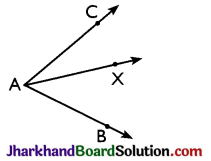
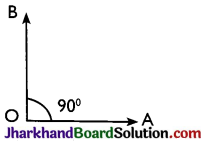
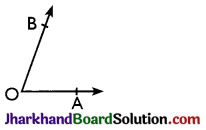
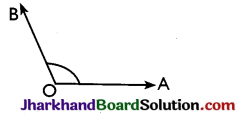

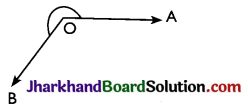
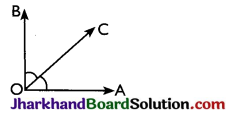
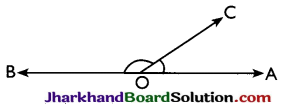
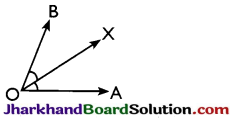
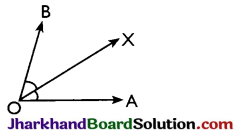

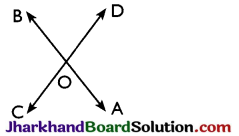
![]()
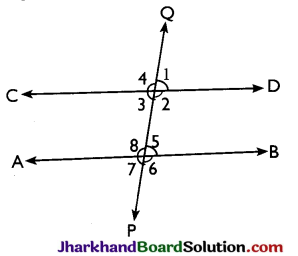
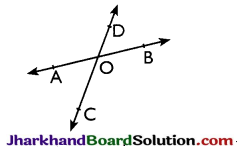
![]()
